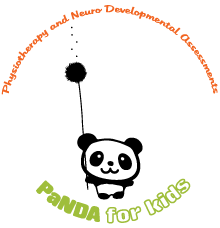Bare feet are an important part of children learning to walk.
Being bare foot helps children with their:
- Sensory development – feeling what they touch with their feet and being exposed to a variety of textures and surfaces;
- Muscle development – of the foot and ankle muscles;
- Proprioception and balance reactions – an important part of standing balance.
When should my child start wearing shoes?
Ideally children should be walking independently for a few months before shoes are introduced. Young children only require shoes for protection when outdoors. Continue to keep your child bare foot indoors and on grass or soft surfaces outdoors.
What do I look for when buying shoes?
- Shoes should fit well, while allowing a little room for growth. Check there is some space from your child’s toes to the front of the shoe.
- The sole of the shoe should be lightweight and flexible. Check that it can bend near the toe.
- Shoes should have a firm heel cup (back of the shoe). Check you cannot squeeze the sides of the back on the shoe together.
- A supportive fastener around the ankle, such as velcro straps, buckles or laces, will provide support and ensure they don’t slip off.
Expensive shoes are not always better. Young children outgrow their shoes very quickly – most will need a new pair 3 or more times each year.
Does my child need foot orthotics?
It is normal for children have ‘flat feet’ until the age of 4- 7 years old and most children will not require orthotics.
However, there are some children for whom foot orthotics may be beneficial. This includes children who have neurological high or low muscle tone; children with very flexible feet and ankles that is affecting their standing and walking; or older children who are having falls or pain.
Talk to your physiotherapist if you feel your child may benefit from orthotics.
There are a number of factors to consider as to whether, and what type of, orthotics will be appropriate. Your physiotherapist will generally work with an orthotist, who assesses and makes orthotics.
Alana Randall, B. App. Sci. (physio); Mast. Physio
Paediatric Physiotherapist
References
Victorian Paediatric Orthopaedic Network. (2010). Shoes for young children – orthopaedic fact sheet. https://www2.health.vic.gov.au/about/publications/policiesandguidelines/Shoes
Victorian Paediatric Orthopaedic Network. (2010). Flat feet in children – orthopaedic fact sheet. https://www2.health.vic.gov.au/about/publications/factsheets/Paediatric-Orthopaedic-Fact-Sheet-for-flat-feet



